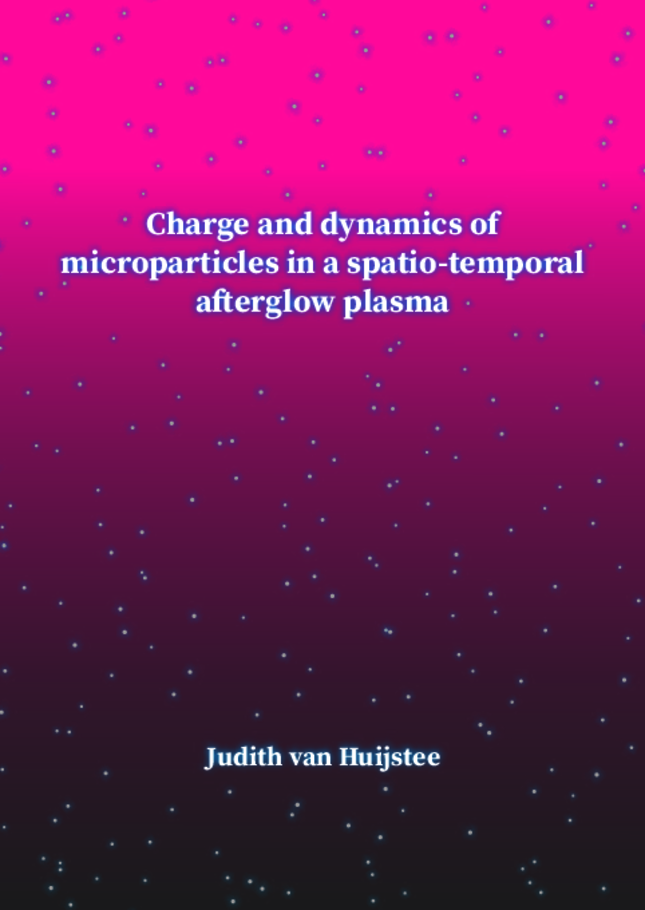The power of plasma in the fight against dust particles
Advanced dust filters contribute to future computer chips as well as public health

Dust, as we all know it from our households, is not only a problem for cleaners. It has serious implications for public health, as well as for the development of faster and more powerful computer chips. So what if we could prevent dust particle pollution? That's not only nice for your smartphone and computer, but also creates opportunities in future scientific research. Moreover, it contributes to air quality and thus people's health. Research shows that plasma is a promising solution as part of a dust filter. Judith van Huijstee therefore studied the interaction between microdust particles and a temporal-spatial plasma afterglow. She defended her thesis on March 6 and received her doctorate with honors.
Plasma is a partially ionized gas and is known as the fourth state of matter, besides the well-known solid, liquid, and gas states. Like dust, everyone has seen plasma at one time or another, such as in the form of lightning, fire, or the sun. When dust enters a plasma, the free electrons and ions of the plasma can collide with the surfaces of dust particles and stick to them, making the dust particles electrically charged. Because electrons are much lighter than ions, they move faster and collide with dust particles more often, so dust typically has a negative charge in plasma.
Applying Coulomb force to a charged particle
To develop a plasma dust filter, the motion of electrically charged objects can be controlled using an electric field. This is because an electric field exerts a so-called Coulomb force on a charged particle, accelerating it in the direction of the field (or against it if it is negatively charged). Through this controlled interaction, pollutant particles can be filtered out of a gas stream, or sent in a machine toward places where their negative impact is less.

The reality is less simple, however, because externally applied electric fields are shielded by a plasma. This is because a plasma is conductive. When the free electrons and ions in a plasma sense an electric field, they, like a charged dust particle, are accelerated. The electrons and ions therefore move until an equilibrium situation is reached, in which there is an electric field only at the edges of the plasma. In the plasma itself, a charged dust particle then no longer notices the externally applied electric field.
Plasma afterglow
To affect the trajectories of dust particles, the dust must be brought from a plasma environment (in which it is charged) to a plasma-free environment (a neutral gas) with an electric field. This transition is called a plasma afterglow. An afterglow can occur both in time (temporal afterglow, after the energy source of a plasma is turned off) and in space (spatial afterglow, the area in space far away from the energy source). In addition, a combination of the two is also possible, a temporal-spatial afterglow. When a dust particle moves from a plasma into a plasma afterglow, its electrical charge changes, an important parameter for the effectiveness of the plasma dust filter. During her doctoral research, Van Huijstee investigated three different topics: how the dust moves in the temporal-spatial plasma afterglow, what the electric charge of the dust is at different locations in the afterglow and what the influence of an applied electric field is on that charge.
Plasma dust filter for use in high tech industry
This knowledge contributes to an improved understanding of the interaction between dust and the tempo-spatial plasma afterglow, making it an important contribution to the development of a plasma dust filter for use in high-tech industry. Devices such as computers and cell phones are becoming increasingly complex over the years, constantly requiring faster and more powerful chips. The very latest generation of chips are only a few millionths of a millimeter in size. A dust particle with a few micrometers in size (a micro dust particle) can therefore already cause serious damage.
In addition, the new knowledge can be used in the development of outdoor dust filters, which can improve the quality of the air and thus the health of the people who breathe it in. Dust is not only annoying in the household, it also poses a serious threat to human health in the form of air pollution. Small dust particles can penetrate deep into the lungs and even enter the bloodstream from there. Among other things, dust causes a variety of lung and heart diseases, sometimes even resulting in death. Advanced dust filters are therefore of vital importance.
Title of PhD thesis: Charge and dynamics of microparticles in a spatio-temporal afterglow plasma
Supervisors: dr.ir. Job Beckers and prof.dr.ir Gerrit Kroesen
Latest news


![[Translate to English:] Photo: Bart van Overbeeke](https://assets.w3.tue.nl/w/fileadmin/_processed_/e/0/csm_BvOF%202019_1031_BHF%20license%20TUe%20ILI%20copy_8a50884392.jpg)